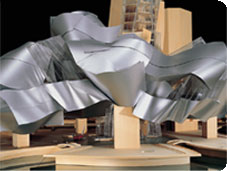 |
|
|
Installation view of metal-mesh sculpture designed by Frank O. Gehry & Associates for the Solomon R. Guggenheim Museum on the occasion of Frank Gehry, Architect, May 18–August 26, 2001. Photo by Ellen Labenski. |
|
In 1962, when Frank Gehry began his own
architectural practice in Santa Monica, California, he was
still coming to terms with the Modernist tradition in which
he had been trained and the character of the metropolitan
Los Angeles area where he was based. Yet by the next
decade, his inimitable aesthetic had begun to emerge in
projects that involved a complete rethinking of the
architectural box and were marked by a striking approach to
the enclosure of space. The synergy between Gehry's
architecture and the urban vernacular of Los Angeles would
take longer to develop, but it eventually flourished in
designs that were animated by the urban complexity on which
they drew.
 |
|
|
Current design model for the Guggenheim Museum New York, 2000. Photo by Ellen Labenski. |
|
From the beginning, the architect's use of
unorthodox materials, such as chain link and corrugated
metal, earned him a reputation as an iconoclast. Stemming
from his interest in both the expressive potential of
materials and the work of the many contemporary artists who
are his friends and collaborators, Gehry's unique
architectural vocabulary lends his buildings a pronounced
sense of power and movement. His humble aesthetic, together
with an idiosyncratic approach to form, exemplifies a
sensibility that melds architecture and sculpture in
exuberant buildings. With each successive commission, he
has succeeded in forging new ground in his ongoing
negotiation of functional architecture and sculptural
form.
This exhibition provides a career-long perspective on the
architect's work through the presentation of 40 projects,
and it reveals a unique design process that begins with
fluid sketches and simple building blocks. Rarely content
with the initial solution, Gehry approaches architecture as
an evolving and collaborative process using models as
three-dimensional sketches to explore the myriad design
possibilities inherent to a given building program. In
recent years, the computer technologies used for design and
manufacturing applications by his firm have facilitated the
realization—on an ambitious new scale—of the
gestural quality he has long prized. His continued penchant
for reinventing materials has likewise reached new heights
of achievement in his use of glass, steel, and titanium.
The remarkable successes of Gehry's latest projects have
catapulted him to a level of prominence enjoyed by few
architects, and today he is recognized as one of the most
inventive and pioneering architects of our time.